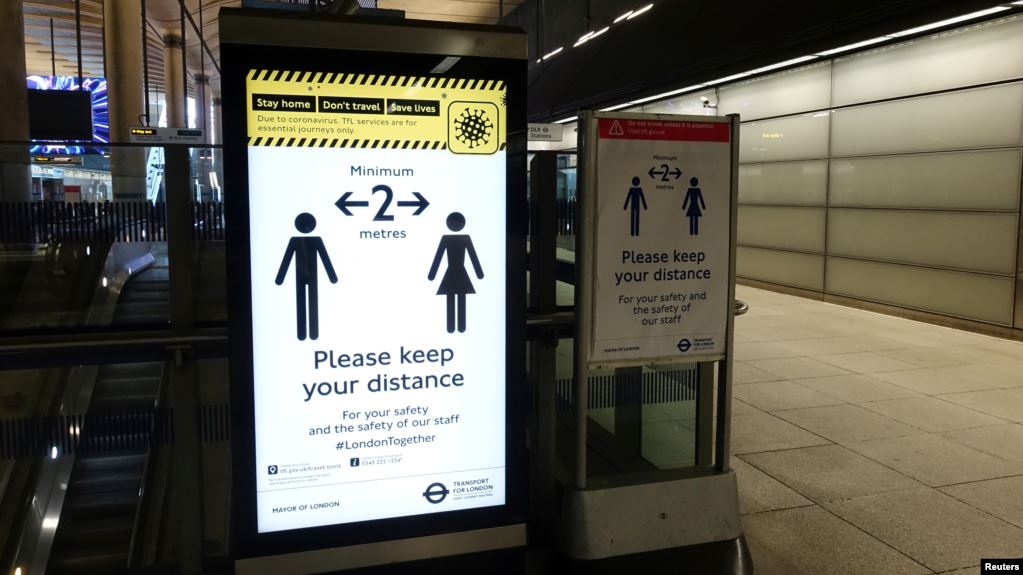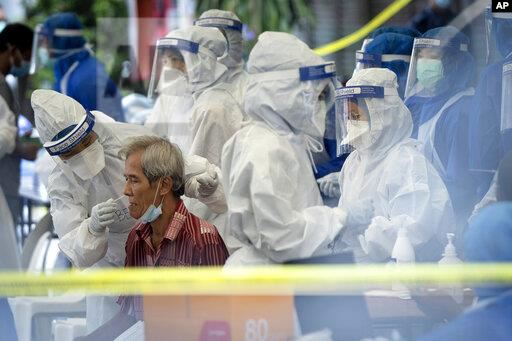پادکست VOA: اصطلاحات انگلیسی – اصطلاحات کرونایی
سلام با هفدهمین قسمت از مجموعه “Words and Their Stories” (کلمات و داستان آن ها) از سری پادکستهای VOA در خدمت شما هستیم. این مجموعه پادکست به توضیح اصطلاحات رایج زبان انگلیسی، داستان ایجاد شدنشون و نحوه استفاده از آن ها در مکالمه می پردازه. در این قسمت از پادکست VOA: اصطلاحات انگلیسی – اصطلاحات کرونایی قراره با کلمه هایی مرتبط با بحران بیماری های جهانی مثل کرونا آشنا بشی. در کنارش چندین کلمه ی جالب و کاربردی دیگه هم یاد میگیری که لیست این کلمه ها به همراه معنی اون ها در پایان مطلب قرار گرفته.
VOA – Words and Their Stories – 17: The Language of an International Health Crisis

متن انگلیسی پادکست VOA: اصطلاحات انگلیسی – اصطلاحات کرونایی :
What is the difference between pandemic and epidemic?
Do infectious and contagious mean the same thing?
How exactly does contact tracing work?
Even native English speakers may not fully know the answers to these questions.
As English learners, you have probably noticed some words and phrases you do not understand when reading reports about the new coronavirus. Today, we look at some of the most common COVID-19 terms.
We can start with epidemic versus pandemic.
An “epidemic” is when a disease spreads through a population and affects many individuals at the same time. An epidemic may affect a community, province or even a whole country.
A “pandemic” is a kind of epidemic — one that spreads to a much larger area or even worldwide. Like many medical-related terms in English, the word comes from Greek. Pan- means “all or every.” The second part of the word, “-demic,” comes from the Greek word demos, meaning “people.”
On March 11, the World Health Organization (WHO) declared the coronavirus crisis a “pandemic.” At a news conference that day, the WHO’s director-general said, “Pandemic is not a word to use lightly or carelessly.” He was reminding people that the word is used only for the most extreme and dangerous situations.
The virus is now present in 213 countries and territories worldwide.

Infectious versus contagious
COVID-19 is infectious and contagious. Infectious — the adjective form of infection — describes diseases that are spread through the environment. Malaria, for example, is an infectious disease. Humans contract the disease through mosquito bites. Malaria, however, is not contagious — or able to be passed from one person to another.
You already know that COVID-19 is easily passed person to person. Common colds and the seasonal flu are also contagious and infectious diseases.
Asymptomatic
The new coronavirus has spread quickly partly because those infected can be contagious before they even know they are sick. In other words, those people are asymptomatic.
This word has a lot going on. Let’s break it down.
A “symptom” is a change in the body that shows a disease is present. For example, we wrote on March 30: “Most people who get COVID-19 experience mild or moderate symptoms, like coughing and high body temperature, or fever.”
“Symptomatic” is the adjective form of symptom. It means “showing that a disease is present.” So, we could say: “A cough and fever are symptomatic of the new coronavirus.”
The prefix “a-” means “without.” So, what happens when we add the letter “a” to “symptomatic?” The word ends up meaning “having or showing no signs of disease.”
Quarantine, isolation and social distancing
Experts know that asymptomatic people can spread the disease. This is partly why officials are urging people to stay at home as much as possible. In some cases, whole countries were put in lockdown — a state of restricted movement put in place as a security measure.
Most people around the world are social distancing. This term is new to everyday English. The U.S. Centers for Disease Control and Prevention, CDC, uses it to describe the act of avoiding gatherings and staying about two meters away from other people.
The World Health Organization is now using the term “physical distancing” instead of social distancing. The term is a little more exact because people can socialize without being near one another.
Social distancing is less extreme than quarantine and isolation.
Isolation separates sick people who have a contagious disease from people who are not sick.
Quarantine restricts the movement of people who were around a contagious person to see if they get sick. In the case of COVID-19, the recommended quarantine period is two weeks, or 14 days. The word was first used in the 1400s in Europe and meant “a period of about 40 days.”
Quarantine can be a noun and a verb. Here it is as a noun: “Early in the coronavirus spread, Vietnam restricted travel into the country and put tens of thousands of people into quarantine.”
And here it is as a verb: “Dr. Fauci quarantined himself after two people who work at the White House were found to have the new coronavirus.”
Contact tracing
Many experts say in order for it to be safe for places to reopen, widespread testing and contact tracing need to be in place.
Contact tracing requires investigative action. Tracers work with confirmed COVID-19 patients to learn whom they have been close to. The tracers then inform those people that they may have been infected. The tracers also provide advice on what actions to take.
In some places, such as South Korea and Singapore, contact tracing started early in the pandemic.

Flatten the curve
Social distancing, isolation and quarantining are all done to help “flatten the curve.” This phrase, now extremely common in the age of COVID-19, means to slow the spread of disease. The same number of people might get sick, but infections happen over a longer period. This eases the pressure on emergency and health care resources.
Hospitals in most areas have a limited number of beds and breathing machines, called ventilators. These machines are extremely important for treating patients with more severe cases of COVID-19.
The health care industry is also limited in respirators. These are special masks, or nose and mouth covers. Medical workers need respirators to protect themselves from contagious patients.
Here is how Ray Chambers, a WHO official, recently used the phrase on Twitter: “More physical distancing + other measures will help to flatten the curve + save lives.”
Chambers also used the term “physical distancing.” This is not as commonly used as social distancing. The two phrases mean the same thing. As Dr. Maria Kerkhove of the WHO said in the early days of the pandemic: “We’re changing to say physical distance and that’s on purpose, because we want people to still remain connected.”
I’m Ashley Thompson.
And I’m Caty Weaver.
لیست واژگان این پادکست
epidemic (اپیدمی) – n. an occurrence in which a disease spreads very quickly and affects a large number of people
pandemic (پاندمی) – n. an occurrence in which a disease spreads very quickly and affects a large number of people over a wide area or throughout the world
infectious (عفونی ) – adj. capable of causing infection
contagious (مسری) – adj. able to be passed from one person or animal to another by touching
lockdown ( تعطیلی) – n. a state of isolation or restricted access put in place as a security measure.
quarantine (قرنطینه) – n. the period of time during which a person or animal that has a disease or that might have a disease is kept away from others to prevent the disease from spreading
isolation (انزوا) – n. the state of being in a place or situation that is separate from others
social distancing (فاصله گذاری اجتماعی) – phrase. the act of avoiding gatherings and staying about two meters away from other people.
flatten the curve (مسطح کردن منحنی برای نمایش شیوع بیماری) – phrase. to slow the spread of disease
ventilator (هواکش) – n. a device for helping a person to breathe
respirator (ماسک تنفسی) – n. a device that filters the air to keep harmful things out of a person’s lungs. There are two main categories: the air-purifying respirator, in which respirable air is obtained by filtering a contaminated atmosphere, and the air-supplied respirator, in which an alternate supply of breathable air is delivered.
امیدوارم از پادکست VOA: اصطلاحات انگلیسی – اصطلاحات کرونایی لذت برده باشید. برای دسترسی به قسمت های دیگر این پادکست می توانید از صفحه ی پادکست VOA – اصطلاحات انگلیسی آکادمی مجازی آموزش زبان ۲۴talk دیدن کنید.
همچنین برای گوش دادن به پادکست های سطح بندی شده British Council می توانید به صفحه ی پادکست British Council آکادمی مجازی آموزش زبان ۲۴talk یا برای گوش دادن به پادکست های BBC به صفحه ی پادکست ۶ دقیقه انگلیسی (BBC) آکادمی مجازی آموزش زبان ۲۴talk مراجعه کنید.
گوش دادن به پادکست روش خوبی برای تقویت مهارت شنیداری و هم چنین یادگرفتن کلمات در بستر یک موضوع خاصه که این به تقویت مهارت مکالمه انگلیسی نیز کمک زیادی می کنه.
اگه دنبال این هستی که مهارت های مکالمه زبان انگلیسیت رو بیشتر از این تقویت کنی بهت پیشنهاد میکنم در دورهی مکالمه زبان انگلیسی آکادمی مجازی آموزش زبان انگلیسی ۲۴talk شرکت کنی که با یه برنامه منسجم و خلاقانه کمک میکنه در زمان کوتاه بتونی به راحتی و روانی انگلیسی صحبت کنی.







